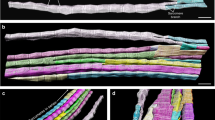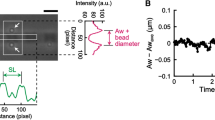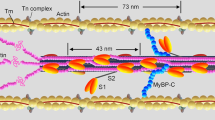Abstract
FREY-WYSSLING1, following Hürthle, explains the isotropy of the J striation in muscle as the crossing of micellar structure. C. E. Hall, M. A. Jakus and F. O. Schmitt2 established by electron micrographs that myofibrils are composed of parallel bundles of filaments lying axial with the fibrils both in the Q and J striations. On the basis of their experiments these authors put forward two hypotheses to explain the isotropy : it is caused either by differences in orientation within the filaments in the J striation, or by a component which compensates the positive birefringence of the filaments.
This is a preview of subscription content, access via your institution
Access options
Subscribe to this journal
Receive 51 print issues and online access
$199.00 per year
only $3.90 per issue
Buy this article
- Purchase on Springer Link
- Instant access to full article PDF
Prices may be subject to local taxes which are calculated during checkout
Similar content being viewed by others
References
Frey-Wyssling, A., "Submikroskopische Morph.", 263 (Berlin, 1938).
Hall, C. E., Jakus, M. A., and Schmitt, F. O., Biol. Bull., 90, 32 (1946).
Szent-Györgyi, A., "Studies on Muscle" (Szeged, 1944).
Straub, F. B., Stud. Instit. Med. Chem., Univ. Szeged, 2, 3 (1942).
Banga, I., and Szent-Györgyi, A., Enzymol., 9, 111 (1940).
Author information
Authors and Affiliations
Rights and permissions
About this article
Cite this article
MATOLTSY, A., GERENDÁS, M. Isotropy in the J Striation of Striated Muscle. Nature 159, 502–503 (1947). https://doi.org/10.1038/159502c0
Issue Date:
DOI: https://doi.org/10.1038/159502c0
This article is cited by
-
Sur les protéines de structure des muscles striés
Experientia (1950)
-
Effect of ultrasonic vibration on muscle fibresin vitro
Experientia (1949)
Comments
By submitting a comment you agree to abide by our Terms and Community Guidelines. If you find something abusive or that does not comply with our terms or guidelines please flag it as inappropriate.



